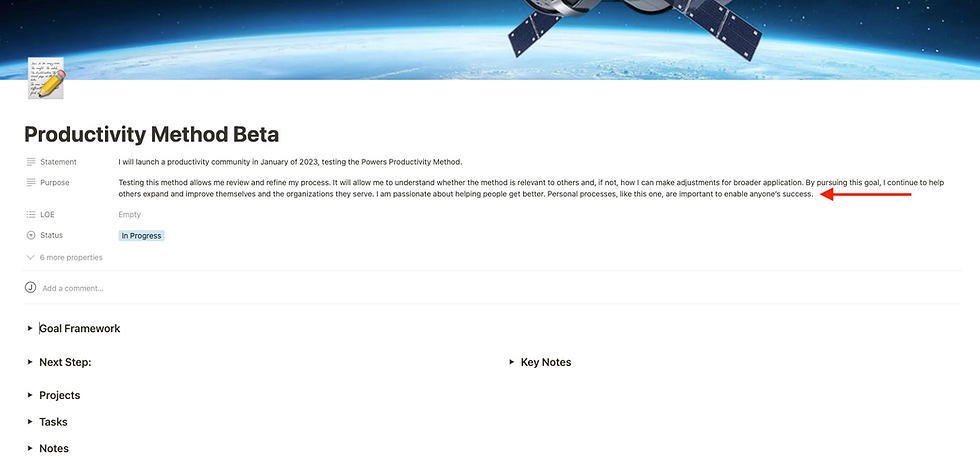Setting Goals
- Josh Powers

- Dec 11, 2022
- 4 min read
Goals. They always seem like a great idea, until it is time to follow through on them. I spent the majority of my first career without an understanding of how to set a goal and, even worse, how to follow through on one. A few years ago, I embarked on a journey to better understand goal setting and become more proficient in the endeavor. This article provides an overview of the simple process I developed to set and achieve goals.

Most notably, I found that goals cannot be viewed as an independent venture. To be realized, goals must be linked to your life’s framework, to the projects you establish, and to the actions you take each day. Successful goal pursuit requires iterative review, revision, and recommitment. That’s right, it is hard work. To connect the dots, I created my own productivity methodology in Notion. Today, I’ll use screenshots from Notion as examples, displaying my goal to beta-test the methodology with a group of users next year. Here is the 5-step process I use to establish goals:
Step #1: Create a goal statement in narrative format.
This simple statement should help you quantify what you are trying to achieve. I use the “smart” goal framework when creating my goal statements. You’ll see references back to this framework throughout this process.
Simple. Simplicity is the opposite of complexity. Keep it simple by minimizing the number of projects associated with goal completion. I find 5 to be the maximum number of projects you can link to a goal before it becomes daunting. Does your goal consist of more projects? Consider splitting it out into multiple goals.
Measurable. You should be able to tell when you’ve completed your goal. To do this, you will need to decide whether you are pursuing an achievement goal or a habit goal. If I want to lose weight, I could create an achievement goal to lose 10 pounds by 01 February 2023. Applying a habit goal, I could eliminate sugar Monday-Saturday from 01 January 2023 to 01 February 2023. Both allow for easy measurement.
Achievable. This is a delicate category and requires a balance between reality and aspiration. For example, saving 1 million dollars in 2023 is not an achievable goal for me given my current income. Creating unachievable goals is counterproductive. Still, you should set goals outside of your comfort zone. They should make you slightly nervous and unsure whether you’ll be successful. Setting easy goals is also counterproductive. As an example, saving $1,000 in 2023 is too easy. It doesn’t take me out of my comfort zone or make me nervous. In other words, I can achieve it without growing.
Relevant. Make sure the goal ties to the objectives in your life’s design.
Timely. Make the goal something you can start and complete within a reasonable time horizon, like within a year.
Here’s my example, captured in my Notion goal template:

Step #2: Identify the goal's purpose.
In a narrative format, capture why the goal is important and how it ties to your life’s design. This statement should expand the relevant considered in the "smart" goal framework. You should update the purpose iteratively as you review each goal.
Here’s my example:

Step #3: Link to your Life Design.
Connecting and reinforcing the linkages to your life’s design relates to relevant in the "smart" goal framework. Maintaining these linkages make sure your goals are aligned with where you want your life to go. Later, reinforcing these links will ensure your daily actions are aligned with goals and, correspondingly, your life’s design. When establishing goals, make sure they are distributed among your personal lines of effort.
My goal links to my professional and community lines of effort:

Step #4: Begin to capture associated tasks and projects.
This step quantifies the simple from the "smart" goal framework. To maintain simplicity, limit corresponding projects to 5 or fewer. Remember, tasks are independent, completable actions. Projects consist of multiple tasks with a common objective. Though most of your actions will fall under projects, there will likely be unassociated tasks. There is no limit to the number of corresponding tasks, if they are tangible and to the point.

Step #5: Assign the next step.
This is a simple yet critical step that must be executed each time you revisit a goal. Review independent tasks and those associated with each project, then assign a next step. Plan to complete this task within the next week and establish it as a focus area. Once you’ve completed the task, assign another next step!

There it is, a summary of my goal-setting methodology. Does it seem too easy? That’s because goal-setting is, inherently, an easy process. You can sit down over a coffee or two and create a solid goal this morning. But a solid framework does not equate to successfully achieving a goal. Success requires a deliberate linkage between your life’s design and the actions you complete on a day-to-day basis. Over the coming weeks, I’ll go into additional detail on these steps of my process.

Comments